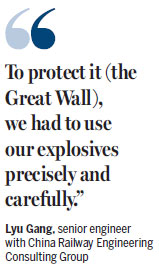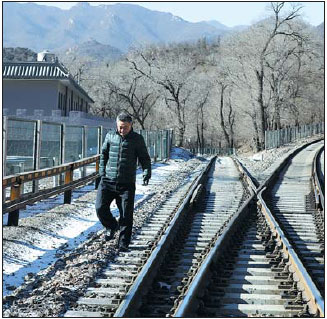Future route serves as symbol of past, potential innovation
The high-speed railway between Beijing and Zhangjiakou, Hebei province - set to enter operation in 2019 - will allow trains to travel at 350 kilometers per hour, 10 times faster than the standard train used a century ago.
The new line will depart from Beijing's North Railway Station and pass through the municipality's Haidian, Changping and Yanqing districts, before entering the territory of Hebei province and further passing through the Guanting reservoir, Huailai county, Xiahuayuan district, Xuanhua district and then Zhangjiakou city.
The route not only connects the two cities but also bridges the northwestern parts of Beijing and Hebei province with a total track length of 174 km.
After seven years of careful planning, construction work began in early 2016.

The Beijing-Zhangjiakou high-speed railway will be China's first ballast high-speed track to be built on windy and frigid land with a design speed of 350 km/h, said Qiao Junfei, deputy chief engineer of China Railway Engineering Consulting Group.
To deal with the impact of such high speed on the bridge structure, the "Bridge (2013)-2321" series beam has been specially developed, which is the world's first standard beam structure for ballast tracks to support these speeds.
The Badaling Great Wall station on the Beijing-Zhangjiakou high-speed railway will have a maximum subterranean depth of 102 meters and will cover 36,000 square meters in terms of construction area, making it the largest and deepest underground railway station in the world, said Luo Duhao, chief engineer of the Beijing-Zhangjiakou railway project department of China Railway No 5 Engineering Group.
To protect the Great Wall heritage and provide convenience for passengers, the constructors of China Railway No 5 Engineering have made several important technological breakthroughs.
The excavation span of the single crossover tunnel totals 32.7 meters, making it the largest single-arch span underground tunnel in China.
The Badaling Great Wall station is the first to use a laminated-layer structure for inbound and outbound tunnels, which completely separates inbound and outbound passengers and allows a balanced space arrangement.
The "circular rescue corridor design" was also devised to ease rescue operations in emergency conditions.
"When building the station, the construction team had to pass near the Great Wall twice," said Lyu Gang, a senior engineer with China Railway Engineering Consulting Group. "To protect it, we had to use our explosives precisely and carefully.
"The underground water we used will be filtered through sewage-treatment processes and go back to nature. We want every move to be in full compliance with the peopleoriented design concept."
The high-speed railway will enter service at the end of 2019, with the travel time from Beijing to Zhangjiakou reduced to 50 minutes.
Cao Yingying contributed to this story.
zhuanti@chinadaily.com.cn
|
A tourist walks by the Y-shaped route, a groundbreaking system on the Beijing-Zhangjiakou railway built during the late Qing Dynasty (1644-1911). The design uses a zigzag alignment, which enables trains to reverse direction and thus makes it easier for trains to run in mountainous regions.Zhu Xingxin / China Daily |
(China Daily 03/07/2017 page8)















